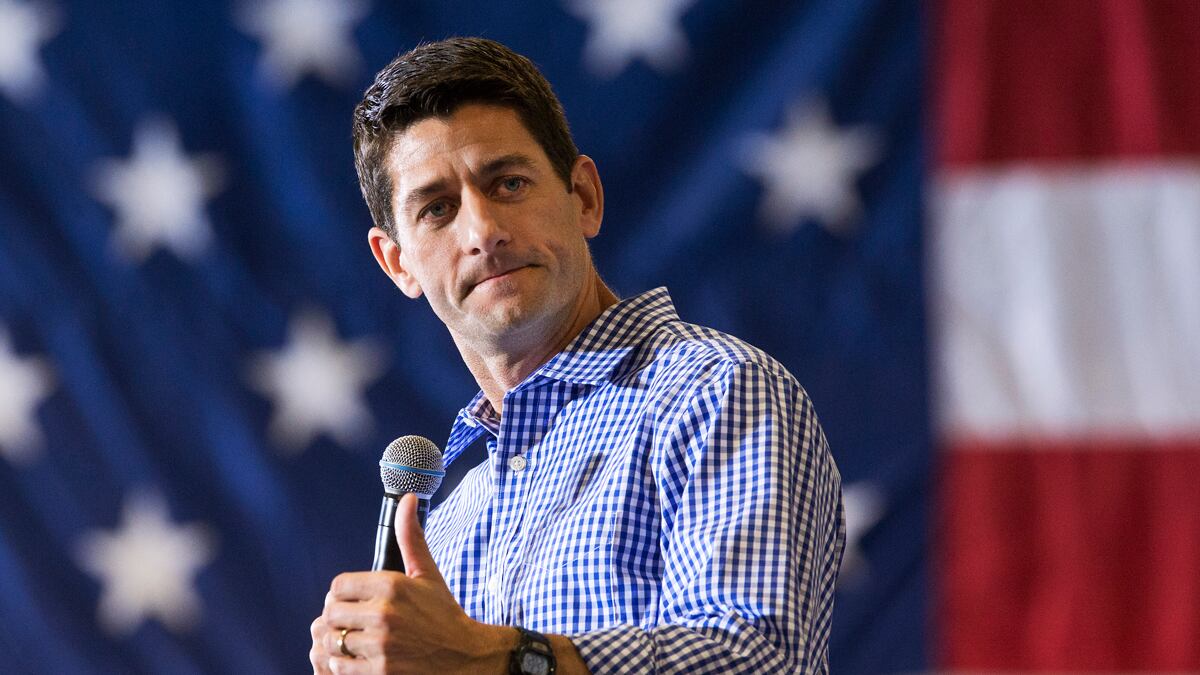Wisconsin Rep. Paul Ryan, the Republican vice-presidential candidate, was a leading member of a task force convened by the state’s Democratic governor in 2008, Jim Doyle, to save a once-flourishing automobile plant in Ryan’s hometown of Janesville, according to state officials.
After General Motors announced on June 3, 2008 that it intended to close the nearly 100-year-old plant by 2010, Ryan joined a core group of about a dozen other Wisconsin officials from both parties in the GM Retention Task Force. Their efforts were ultimately unsuccessful, and the company suspended all operations at the facility by Dec. 23, 2008, eliminating 2,400 jobs. It has been in “standby” mode since.
In his role on the task force, Ryan—the House Budget Committee chair whose plans to reduce the size of government and with it the extent of what he’s called “crony capitalism” made him a national figure—negotiated directly with GM executives about a taxpayer-funded “incentive package” to try to convince the company to keep the plant in his district running.
ADVERTISEMENT
Ryan was one of 32 Republicans who voted for the $14 billion auto bailout in December 2008, arguing at the time that it was a better idea than using TARP money, which he opposed. A month before the bill passed, he warned about the dangerous precedent the bailout would set: "Is it airlines? Steel companies? Is it widget manufacturers? Where does it end?"
The task force of which Ryan was a member went as far as to explore the possibility of using funds from the $789 billion stimulus deal approved by Congress, task-force members said, a package Ryan voted against and publicly called a “wasteful spending spree.”
One reason why House members rarely end up on presidential tickets, aside from representing far fewer voters than senators or governors, is that they have to balance their national views with the needs of their districts (and Ryan’s in particular heavily dependent on the auto industry). While Ryan initially denied an Associated Press report this week that, despite opposing the bill, he’d asked for stimulus money for two companies in his district, he later acknowledged he had, calling it a “constituent-service matter.”

In 2008, presumptive Republican nominee and Ryan running mate Mitt Romney penned a New York Times editorial titled "Let Detroit Go Bankrupt.” Ryan’s congressional offices forwarded The Daily Beast’s questions about Ryan’s role on the task force to Mitt Romney’s campaign. Romney campaign spokesman Brendan Buck did not return requests for comment.
The Janesville GM factory was once the centerpiece of the bustling company town where Ryan grew up, where his great-grandfather founded a now-national construction company, and where he maintains a home to this day. Former task-force members as well as press releases and a letter from Ryan’s office show the important role Ryan played when GM moved to shut down the plant, which at its height employed as many as 7,000 people, and was one of two operating at the time in Janesville.
Tim Cullen was a member of the Janesville school board when Gov. Jim Doyle asked him to co-chair the task force along with United Auto Workers 95 President Brad Dutcher to fight the shutdown. Ryan or his chief of staff attended all the meetings held by the task force, Cullen said, adding, “We worked with officials from both parties, the local health-care sector, local government, the county, and the city to try to put together a package, a proposal to try to get them to stay in Janesville.”
Cullen also said “There was not another elected official who tried harder than Paul Ryan to save the plant,” and that Ryan’s chief of staff, Andy Speth, was often Ryan’s liaison to the task force. A task-force member said that the congressman’s office became an important point of contact between GM and the task-force members working to save the plant.“What Paul did was whenever we asked him to try and get a hold of someone in Detroit or General Motors, he would do it,” Cullen said.
Those efforts included coordinated efforts with state Democrats and labor leaders, meetings with GM executives, and sending a letter to GM on behalf of the Janesville plant.
On June 3, 2008 Ryan sent a letter to Wagoner cosigned by Feingold and Sen. Herb Kohl. In it, they asked the company to consider the importance of the plant to the town, as well as to explore bringing new product lines to the facility.
“The Janesville GM plant has a continued role to play in the future success of GM and we ask that GM reconsider the decision to close the Janesville plant,” the legislators wrote.
In asking the company to explore new products, the legislators reminded the company that: “market demand in the automobile industry is changing and that GM intends to adapt to the changing demand to remain a viable company …a retooled Janesville GM plant can assist in GM’s efforts to adapt to a changing market.”
“He was completely dedicated,” Cullen said of Ryan’s involvement in the task force. “This is his home town, and he has been the world enough to know that what happens to a town the size of Janesville when it loses a plant of this size.”
Rock County economic development manager James Otterstein was also on the task force with Ryan. Otterstein’s role was to coordinate the activities of the various members of the task force, and said he worked directly with Ryan’s office on many occasions.
“Our entire federal delegation that represented Rock County was involved, but certainly Congressman Ryan and his staff carried a different role and performed different responsibilities during the course of the task force,” Otterstein said, “and that was primarily because of the personal contacts that Congressman Ryan had at the time with the C-suite executives at General Motors.”
In September of 2008, Ryan traveled to Detroit with three Democrats—Sen. Russ Feingold, Rep. Tammy Baldwin, and Gov. Doyle—to meet directly with GM executives and ask them not to close the plant.
In a statement released after that meeting, Ryan, along with Feingold and Baldwin, said that they had met with GM Chief Executive Richard Wagoner, Jr. and “made clear what a tremendous asset the people of Janesville’s GM plant are to GM, and how important GM jobs are to the Janesville community.”
The task force wound up presenting GM with hundreds of millions of dollars in inducements to keep their plant in Janesville running. Documents obtained by the Milwaukee Journal-Sentinel show that the package of incentives presented to GM executives by Wisconsin officials wound up totaling $409 million in combined public and private funds to get the company to choose Janesville over a site in Michigan to produce a new small-car line.
The package, which GM ultimately declined, included $100 million in tax credits, $213.14 million in concessions from local union workers, $24 million from health care providers and insurers, and half a million dollars in contributions from private companies in the area. The package also offered up $20 million from Rock County and $15 million from the city of Janesville itself.
“We leaned on [Ryan’s] office more heavily than anybody else, and his office consistently delivered,” Otterstein said. “In terms of whatever the ask list was they were extremely efficient and expeditious with everything.” Otterstein said that the task force explored the possibility of using federal stimulus funds, though they never submitted any applications for federal funds.
“We literally had explored each and every possible source of public as well as private sector funding that we were privy to to create what we thought would be the most competitive package for us,” Otterstein said. “And then we certainly went to the next level with having additional direct contact with the program administrator.”
“We relied on Andy [Speth] quite extensively to help not only open those channels but to keep those channels open,” Otterstein said.
Dutcher said that he is prohibited from discussing the terms of the incentive package offered to GM due to a confidentiality agreement he signed with the State of Wisconsin. Dutcher did say that “I can confidently say that if there were funds available from the federal government that could have gone into this package we would have gone after it.”
Peter Conway is a proud member of the UAW and U.S. Army veteran who worked at the Janesville plant until the day it closed. After 17 months of unemployment spent living on the hope that GM would reopen the plant in the town where he, like Ryan, was brought up, the husband and father of two accepted a job at another GM location about 500 miles away in Lordstown, Ohio.
Conway says he went to the same high school as Ryan, who is seven years his junior, and remembers that they both came of age in neighborhoods filled with people who had worked 20, 30, even 40 years at the GM plant.
At a campaign stop on Thursday, Ryan claimed that President Obama had promised to “keep the plant open” in Janesville, and laid the blame for its closure at the president’s doorstep even though Obama did not take office until after the facility had closed. Ryan, who task force members said did everything he could to keep the plant open, said that Obama’s purported words were “one more broken promise.”
When the governor and other officials, including Ryan, went to bat against GM for the workers, Conway said, it seemed like the plant just might have a chance. “We had great expectations that they were going to save the Janesville plant,” Conway said. “We put a lot of weight on their shoulders, thinking they would be our knights in shining armor.”






